Science : Term 2 Unit 2 : Electricity
EVALUATION
I. Choose the correct answers
1. In the circuit diagram below, 10 units of electric charge move past point x every second What is the current in the circuit ___________

a. 10 A
a. 1 A
c. 10 V
d. 1 V
Answer: a) 10A
2. In the circuit shown, which switches (L,M or N) must be closed to light up the bulb?
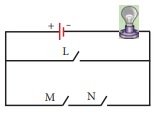
a. switch L only
b. switch M only
c. Switch M and Nonly M N
d. either switch L or switches M and N
Answer: d) either switch L or switches M and N
3. Small amounts of electrical current are measured in milliampere (mA). How many milliampere are there in 0.25 A ?
a. 2.5 mA
b. 25 mA
c. 250 mA
d. 2500 mA
Answer: c) 250 mA
4. In which of the following circuits are the bulb connected in series?

Answer: B
II. Fill in the blanks.
1. The direction of conventional current is opposite to electron flow.
2. One unit of coulomb is charge of approximately 6.242 × 1018 protons or electrons.
3. Ammeter is used to measure the electric current.
4. In conducting materials electrons are loosely bounded with atoms.
5. S.I. unit of Electrical conductivity of a conductor is Siemens / meter (S/m).
III. True or False – If False give the correct answer
1. Electron flow is in the same direction to conventional current flow. (False)
Electron flow is in the opposite direction to conventional current flow.
2. The fuse wire does not melts whenever there is overload in the wiring. (False)
The fire wire melts whenever there is overload in the wiring.
3. In a parallel circuit, the electric components are divided into branches.
4. The representation of the electric current is A. (False)
The representation of the electric current is I.
5. The electrical conductivity of the semiconductor is in between a conductor and an insulator. (True)
IV. Match the following
1 .Cell – used to open or close a circuit
2. Switch – safety device used in electric circuit
3. Circuit – A complete path for the flow of an electric current
4. Miniature – Reset by hand, circuit circuit becomes complete once Breaker again
5. Fuse – A device which converts chemical energy into electrical energy
Answer:
1 .Cell – A device which converts chemical energy into electrical energy
2. Switch – used to open or close a circuit
3. Circuit – A complete path for the flow of an electric current
4. Miniature circuit Breaker – Reset by hand, circuit becomes complete once again
5. Fuse – safety device used in electric circuit
V. Analogy
1. Water : pipe : : Electric current : wire.
2. Copper : conductor : : Wood : non-conductor.
3. Length : metre scale : : Current : Ammeter.
4. milli ampere: micro ampere : : 10-3A : 10-6
VI. Assertion and Reason
1. Assertion (A) : Copper is used to make electric wires.
Reason (R) : Copper has very low electrical resistance.Option:
a. Both A and R are true and R is the correct explanation of A.
b. Both A and R are true but R is NOT the correct explanation of A.
c. A is true but R is false.
d. A is false but R is true.
e. Both A and R are false
Answer: A. Both A and R are true and R is the correct explanation of A.
2. Assertion (A): Insulators do not allow the flow of current through themselves.
Reason (R) : They have no free charge carriers.
a. If both A and R are true and the R is correct explanation of A.
b. If both A and R are true but R is not a correct explanation of A.
c. If A is true and R is false.
d. If both A and R are false.
Answer : B. If both A and R are true but R is not a correct explanation of A.
VII. Very short answer
1. What is the speed of electric current?
280,000,000 meters per second.
2. What is the S.I unit of electrical conductivity?
Siemens/meter (S/m)
3. Name the device used to generate electricity.
Electric cell
4. Define fuse.
The fuse is a wire that melts whenever there is an overload of current in a circuit.
5. Name some devices that run using heat effect of electric current
Electric stove, geyser, room heater, electric iron.
6. Name few insulators.
Rubber, plastics, glass, wood.
7. What is a battery?
A battery is a collection of one or more cells in a circuit.
VIII. Short Answer
1. Define an electric current.
An electric current is a flow of electric charge or the amount of charge flowing through a given cross section of a material in unit time.
2. Differentiate parallel and serial circuits.
Parallel Circuit — A circuit in which there are multiple paths for electricity to flow. Each load connected in a separate path receives the full circuit voltage, and the total circuit current is equal to the sum of the individual branch currents.
Series Circuit — A circuit in which there is only one path for electricity to flow. All of the current in the circuit must flow through all of the loads.
3. Define electrical conductivity.
Electrical conductivity or specific conductance is the measure of a material’s ability to conduct an electric current.
IX. Long Answer
1. Explain the construction and working of an Telephone.
In telephones, a changing magnetic effect causes a thin sheet of metal (diaphragm) to vibrate. The diaphragm is made of a metal that can be attracted to magnets.
1. The diaphragm is attached to spring that is fixed to the earpiece.
2. When a current flows through the wires, the soft – iron bar becomes an electromagnet.
3. The diaphragm becomes attracted to the electromagnet.
4. As the person on the other end of the line speaks, his voice causes the current in the circuit to change. This causes the diaphragm in the earpiece to vibrate, producing sound.
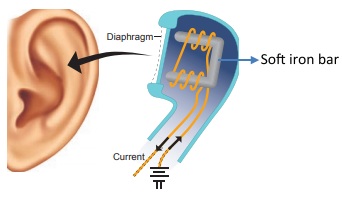
2. Explain the heating effect of electric current.
When an electric current passes through a wire, the electrical energy is converted to heat.
In heating appliances, the heating element is made of materials with high melting point. An example of such a material is nichrome (an alloy of nickel, iron and chromium).
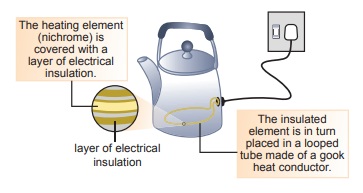
The heating effect of electric current has many practical applications. The electric bulb, geyser, iron box, immersible water heater are based on this effect. These appliances have heating coils of high resistance. Generation of heat due to electric current is known as the heating effect of electricity.
Factors affecting Heating Effect of current
1. Electric Current
2. Resistance
3. Time for which current flows
3. Explain the construction and working of a dry cell.
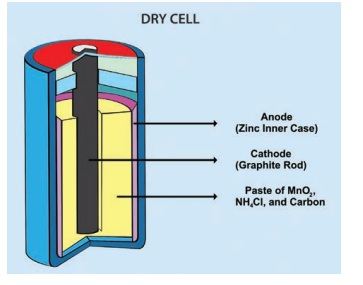
A dry cell is a portable form of a leclanche cell. It consists of zinc vessel which acts as a negative electrode or anode. The vessel contains a moist paste of saw dust saturated with a solution of ammonia chloride and zinc chloride.
The ammonium chloride acts as an electrolyte. (Electrolytes are substances that become ions in solution and acquire the capacity to conduct electricity).
The purpose of zinc chloride is to maintain the moistness of the paste being highly hygroscopic. The carbon rod covered with a brass cap is placed in the middle of vessel. It acts as positive electrode or cathode.
It is surrounded by a closely packed mixture of charcoal and manganese dioxide (MnO2) in a muslin bag. Here MnO2 acts as depolarizer. The zinc vessel is sealed at the top with pitch or shellac. A small hole is provided in it to allow the gases formed by the chemical action to escape. The chemical action inside the cell is the same as in leclanche cell.
X. Higher Order Question
A student made a circuit by using an electric cell, a switch, a torch bulb (fitted in the bulb holder) and copper connecting wires. When he turned on the switch, the torch bulb did not glow at all. The student checked the circuit and found that all the wire connections were tight.
* What could be the possible reason for the torch bulb not glowing even when the circuit appears to be complete?
The filament in the bulb must be fused. The cell may be without electric charge.
XI Picture based Questions
1. Three conductors are joined as shown in the diagram
The current in conductor RS is 10 A. The current in conductor QR is 6 A. What will be the current in conductor PR
a. 4 A
b. 6 A
c. 10 A
d. 16 A
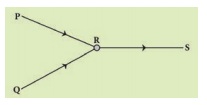
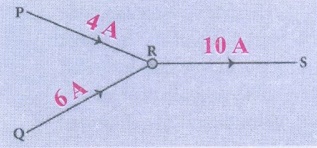
Answer : a) 4 A
2. Draw the circuit diagram for the following series connection
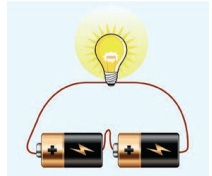
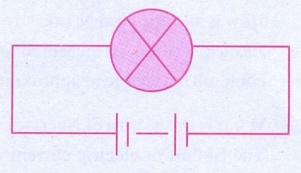
3. Study the electric circuit below. Which of the following switches should be closed so that only two bulbs will light up
a. S1,S2 and S4 only
b. S1, S3 and S5 only
c. S2, S3 and S4 ony
d. S2, S3 and S5 only

Answer : a) S1,S2 and S4 only
4. Study the three electric circuits below. Each of them has a glass rod (G), a steel rod (S), and a wooden rod (W).
In which of the electric circuits would the bulb not light up .
a. A only
b. C only
c. A and B only
d. A , B and C
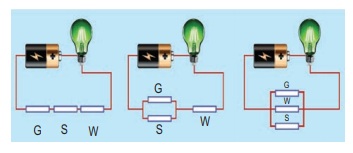
Answer : c) A and B only
Numerical Problems
Worked example 2.1
If 30 coulomb of electric charge flows through a wire in two minutes, calculate the current in the wire?
Solution
Given :
Charge (q) = 30 coulomb
Time (t) = 2 min x 60s
= 120 s
Current I = q/t = 30C/120s = 0.25 A
Worked Examples 2.2
If 0.002A current flows through a circuit, then convert the current in terms of micro ampere?
Solution:
Given that the current flows through the circuit is 0.002A
We know that
1A=106µA
0.002A = 0.002 × 106 µA
= 2 × 10-3 × 106 µA
= 2×103µA
0.002A = 2000 µA
Student Activities
ACTIVITY 1
Comb your dry hair. Immediately after combing the dry hair, bring the comb closer to the bits of paper . what will you observe?

When you are getting up from the plastic chair , the nylon shirt seems to be stuck tothe chair and make crackling sound. What is the reason for the creation of the sound? A balloon sticks to wall without any adhesive after rubbing on your hand. Do you know the reason for all?
In all the above activities, when a body is rubbed against some other body become charged.
Conventional current is in the direction opposite to electron flow.
1 milliampere (mA) = 10-3 ampere.
= 1/1000 ampere
1 microampere (µA) = 10-6 ampere
= 1/1000000 ampere
ACTIVITY 2
Shall we produce electricity at our home?
Materials required:
Zinc and copper electrodes, a light blub, connecting wires, and fruits such as lemons, orange,apples, grapes, and bananas.

Procedure:
1. Set up a circuit as shown in figure
2. Note the brightness of the blub when the circuit is connected to a lemon.
3. Repeat the experiment using the other fruits listed above. Do you notice the differences in the brightness of the bulb when it is connected to different fruits? Which fruit gives the greatest brightness? Why? (If you do not know please get the appropriate reason from your teacher)
Inference:
In the above activity what makes enabled the bulb to glow. Why there is a difference in the brightness of the bulb? The reason is that the fruits which you have connected to the bulb produces the electric energy at different levels
The sources which produce the small amount of electricity for shorter periods of time is called as electric cell or electro chemical cells. Electric cell converts chemical energy into electrical energy
ACTIVITY 3
I am so exhausted. I am going to faint. What first aid will you give me to wake up?
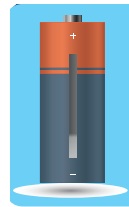
I’ll recharge the secondary cell by connecting it to an electrical circuit.
The dry cell is not really dry in nature but the quantity of water in it is very small, as the electrolyte is in thefrom of a paste. In other cells, the electrolyte is usually a solution

ACTIVITY 4
Make your own switch
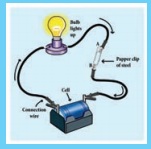
Let us make a switch of our circuits. Take 10 cm long iron strip. Bend it twice as shown in figure. Now drive a nail into the bend of the wooden block. Nail one end of the strip to the other end of the wooden block so that its free end rests just above the first nail without touching it. Your switch is ready.
Would you like to test your switch? To do so, first set up the circuit as shown in the figure.
How would you use the switch to open or close the circuit.
If the bulb in your circuit glows when the metal strip of your switch is pressed on the nail and turns off when it is not, then your switch is working. The switch you made is a simple one. You may have seen many different types of switches on switchboards and appliances at your home and school. The switches are designed according to their usage, convenience and safety. But all of them work on the same principle. Switch is a mechanical component that consists of two or more terminals that are internally connected to a metal strip. Commonly used switches are listed below:

All muscles of our bodies move in response to electrical impulses generated naturally in our bodies

Short circuit
You might have observed the spark in the electric pole located nearby your house. Do you know the cause of this electric spark? This is due to the short circuiting of electricity along its path. A short circuit is simply a low resistance connection between the two conductors supplying electrical power to any circuit. Arc welding is a common example of the practical application of the heating due to a short circuit.

This is the material used in SIM Cards, Computers, and ATM cards. Do you know by which material I am made up off?
The chip which are used in SIM Cards, Computers, and ATM cards are made up of semiconductors namely, silicon and germanium because of their electrical conductivity lies between a conductor and an insulator.
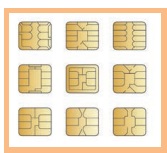
Wires made of copper, an nelectrical conductor, have very low resistance. Copper wires are used to carry current in households. These wires are in turn enclosed in electrical insulators, or materials of high electrical resistance. These materials are usually made of flexible plastic.
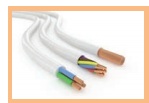
ACTIVITY 5
Materials required
* Iron nail
* Battery & Switch
* Wire
Take around 75 cm long piece of insulated flexible wire and an iron nail say about 8 – 10 cm long. Wind the wire tightly around the nail in the form of a coil. Connect the free ends of the wire to the terminals of a cell as shown. Place some pins on or near the end of the nail. Now switch on and switch off the current, What happens?
When the switch is kept in on position the pins starts to cling to the end of the nail.
When the electric current is switched off the coil generally loses its magnetism. Such coils are called as electromagnets.
The polarities of both ends of the coil changes according to the direction of electric current passes.















